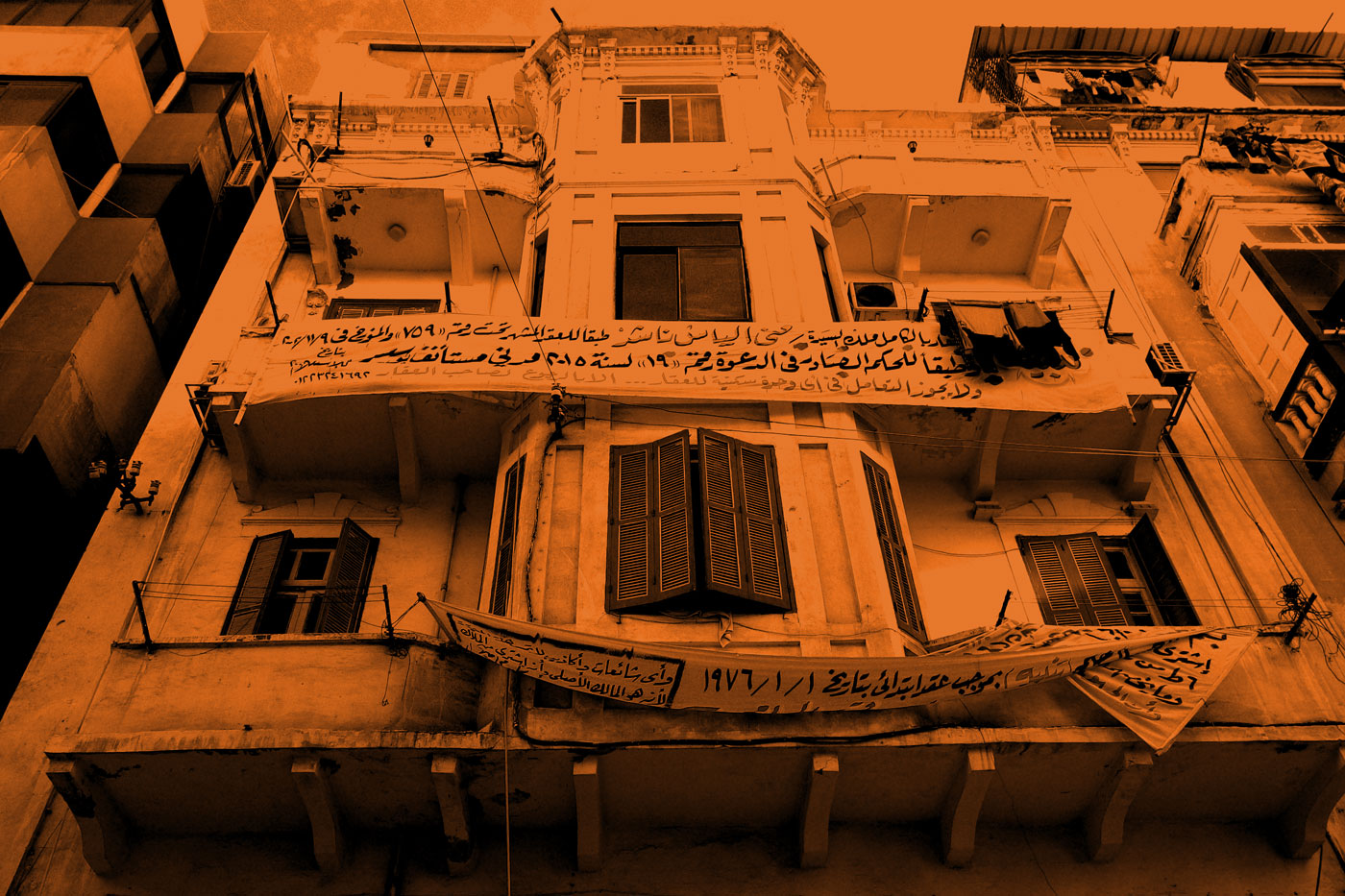Secure Tenure
Table of Contents

Summary
An estimated 70% of Egyptian households live without secure tenure. The rural Delta governorate of Gharbia had the highest proportion at 93% without secure tenure. The Frontier governorate of South Sinai had the least, at 8% of households.
An unspecified number will be faced with forced eviction and the demolition of their homes without compensation. In the case of expropriation/eminent domain, informal housing is not viable for compensation. The remaining families living in informal housing do not enjoy full legal recognition. They may face steep regularization fees, or are forced to bribe local officials to maintain their status quo.
How is insecure tenure a problem?
Insecure tenure is a major risk on the social security of households as they may face eviction at any point of time and end up homeless. Between 1997 and 2013 an estimated 41,239 families were relocated under the pretexts of urban renewal and slum clearance.[1] The majority (58.5%) of households were forcibly resettled, mostly on city outskirts far from their original place of residence. There they face extreme economic and social hardship in terms of finding jobs and sending children to school.[2] In many cases the evictions or relocations are driven by state-owned companies looking to capitalize on their assets, as land prices have been booming over the last decade.[3]
In addition to the forced relocations, these projects often result in making many families homeless since the official tallies do not account for all of the residents, or those who are unable to prove their tenancy. In a recent forced relocation scheme where over 1000 families were tallied, officials stated that only half were eligible for alternative housing, while the rest would not be compensated.[4] In the case of expropriation for public benefit (eminent domain in the US, compulsory purchase order in the UK), informal housing is not viable for compensation.
The remainder of families living in informal housing not in imminent danger of being demolished (does not stand in the way of a road, highway or urban development or gentrification plan), do not enjoy full legal recognition. Those may face the need to pay bribes,[5] or steep regularization fees. According to an early draft of a regularization law currently being debated in parliament, these fees will be between EGP 100 to 1000 per square meter. [6] This is roughly equal to the cost of building.
Who lives without secure tenure in Egypt?
There are three layers of informal tenure in Egypt: land tenure (on which the unit is built), primary unit tenure (original owners) and secondary unit tenure (tenants).
This indicator can only assess primary unit tenure insecurity based on a comparison between units built with or without a permit. Based on this, we have been able to estimate insecure tenure at 70% of all households, or about 14 million households (see methodology). Overall the rural “land-locked” governorates of the Delta (which do not have vacant desert land), had the highest incidence of informal tenure ranging between 56% in Damietta to 93% in Gahrbia. In contrast, in the largely rural Upper Egypt, though these governorates have ready access to desert land, informal tenure ranged between 51% in Luxor to 79% in Fayoum. Within the metropolis of Greater Cairo, the two governorates with rural land, Giza and Qalubia had much higher rates of informal tenure (84% and 83% respectively) than the largely urban Cairo (47%). Frontier desert governorates had relatively low incidences of informal tenure: between 8% in South Sinai and 28% in Matruh.
The method for estimating informal tenure is biased towards underestimation as it based on formal connections to the National Grid. It thereby ignores all informal buildings not connected formally, a fact that is acute in the Desert governorates, which show an unusually low incidence of informality as much land in that region is adversely possessed by locals. Many other households without secure tenure do not appear in this dataset because they are squatting in formal or informal units, or they are informal tenants of both formal or informal units. For example, the Informal Settlements Development Facility inventoried over 120,000 units, home to almost half a million people, built by squatters on state-owned land.[7] The Awqaf (religious endowments authority) claims that it owns 4000 hamlets,[8] which could be home to no less than four million people. However, much land under the Awqaf is rife with unclear tenure issues.[9]
Why do people lack secure tenure?
Overall, most of tenure informality, which inevitably leads to tenure insecurity, is due to the units themselves being informally built: whether on private agricultural land that has been illegally subdivided and urbanised (the majority), or on squatted land. Most people seem to build informally because of the lack of an affordable and appropriate alternative. While the state has been building so-called New Cities over the last four decades, where the bulk of formal serviced land is being offered, the annual rate of provision has been almost a quarter of the amount of private agricultural land being informally urbanised.[10]
Even for those who live in formally built units, tenure may fall into informality over time. A 1998 study concluded that formal registration of property was often not sought; This is mostly because of complex and protracted steps to register property which can include some 77 bureaucratic procedures and take between 6 to 14 years to complete. [11] Costs of registration are also high. Over time, decades of inheritance will complicate ownership.
Rental and in-kind use of units is also largely informal. This ranges from verbal contracts outlining the in-kind use of rooms by bawabs (porters), to the informal sub-letting of rooms by bawabs on roof tops or basements out of sight of absentee landlords, as well as the illegal sub-letting of public housing that was supposed to be for the sole use of the original beneficiary.
In the end, the lax and arbitrary enforcement of the rule of law, has allowed informal tenure to become the norm.
What can be done?
- Introduce a program to recognize all informal tenure within five years through a range of measures based on the different typologies which can include: formal amnesty form eviction and forced relocation, usufruct leases and land titles.
- Introduce legal reform to streamline tenure related legislation and prevent future cases of informal tenure, and fast-track existing tenure-related court cases.
- Establish national council for secure tenure to coordinate informal tenure recognition program and launch investigations into state-affiliated agencies accused of not implementing the law or practicing forced eviction through direct or indirect methods.
- Form urban policy that makes available affordable, appropriate formal serviced land for urban exp
Methodology
Definitions:
Legal Security of tenure is one of the entitlements of the right to adequate housing. Accordingly, the United Nations states that “housing is not adequate if its occupants do not have a degree of tenure security which guarantees legal protection against forced evictions, harassment and other threats”[12].
The United Nations Human Settlements Programme defines security of tenure as “the right of all individuals and groups to effective protection by the State against unlawful evictions”[13].
Egypt’s 2014 constitution guaranteed the security of tenure as per article 78 “The state guarantees the citizens’ right to adequate, safe and healthy housing…”[14].
Measurement Tools:
The legal security of tenure indicator can only inform about the overall legal context and general application of tenure regulations in the country. Therefore, there are two tools for measuring this indicator; [15]
- Authorized Housing: this tool measures the extent to which the urban population is housed legally. Only housing with a clear title to the land on which it stands, and which is constructed in accordance to all required building, land use, or land subdivision permits is regarded as authorized housing. And it is measured through calculating the “percentage of the total housing stock in compliance with current land and building regulations”.
- Evictions: this tool measures the degree to which eviction practices are still in force through calculating the “average annual number of men-headed and women-headed households evicted from their dwellings during the past five years”.
Those two measurement tools together are supposed to give an overall legal context and actual application of tenure regulations in the country.
Methodology for measuring insecure tenure in Egypt
In the absence of official statistics on informal tenure or evictions in Egypt, we were only able to estimate informal house building on the sub-national governorate level.
This was possible by using official statistics on net new residential electricity subscribers per year,[16] as well as official statistics on net new formal housing units built per year (government and formal private sector).[17] We assume the difference as units built by the informal private sector. In order to iron out lags inherent in the data (informal housing units are allowed to have formal electricity subscriptions in bulk), as well as spikes or troughs in construction related to economic or political factors, the average number of units over an eight-year period, 2006/2007 to 2013/2014, was used.
Data limitations due to multiple layers of estimations mean that this is an indicator of informal construction, and actual numbers may vary. For example, there may be an over counting of formal construction as data is based on building permits being issued, but not necessarily implemented. On the other hand, informal construction is under-estimated as the data set assumes all informal units to have formal subscriptions to the grid, being forced to ignore a proportion of units that do not have formal subscriptions. High rates of vacancy are present in both formal and informal construction. The lack of in-depth data lead us to assume and equal proportion in each, while incidences of crowding may be higher in informal housing. Therefore, the assumption was made that one unit is home to one household, where the data will generally underestimate informal units and overestimate formal ones.
Ultimately this data set is focused on primary unit tenure, and does not include households squatting on state-owned land, or informal secondary tenure such as sub-letting, in-kind use or squatting.
Footnotes
[1] Shawkat Y., Al-'Adala al-igtima'eya wal-'omran, kharitit Masr. Cairo: Shadow Ministry of Housing, 2013. Pp82-83 https://www.academia.edu/4975995/Social_Justice_and_the_Built_Environment_A_Map_of_Egypt_Ar_%D8%A7%D9%84%D8%B9%D8%AF%D8%A7%D9%84%D8%A9_%D8%A7%D9%84%D8%A5%D8%AC%D8%AA%D9%85%D8%A7%D8%B9%D9%8A%D8%A9_%D9%88%D8%A7%D9%84%D8%B9%D9%85%D8%B1%D8%A7%D9%86_%D8%AE%D8%B1%D9%8A%D8%B7%D8%A9_%D9%85%D8%B5%D8%B1 [2] Tadamun 2015. The Hidden Cost of Displacement: The Move from `Izbit Khayrallah to Masākin `Uthmān, 31.12.2015 http://www.tadamun.info/2015/12/31/hidden-cost-displacement-move-izbit-khayrallah-masakin-uthman/?lang=en#.V0Lrb-Sm0ox [3] Shawkat 2016. Property Market Deregulation and Informal Tenure in Egypt: A Diabolical Threat to Millions. Architecture_MPS, Volume 9, Number 4, June 2016, pp. 1-18(18). UCL. http://www.ingentaconnect.com/contentone/uclpress/amps/2016/00000009/00000004/art00001 [4] Security Forces Empty Tel al-'Aqarib by Force... and the Municipality Cuts Water and Electricity, al-Masry al-Youm, 22.05.2016 http://www.almasryalyoum.com/news/details/952321 [5] Sejourne, Marion. "Inhabitants' Daily Practices to Obtain Legal Status for Their Homes and Security of Tenure: Egypt." In Popular Housing and Urban Land Tenure in the Middle East: Case Studies from Egypt,, by Myriam ABABSA, Baudouin DUPRET and Eric DENNIS. American University in Cairo Press, 2012. [6] "Qanun al-tasaluh fi mukhalfat al-bina'", Parlamany, 05.05.2016 http://www.parlmany.com/News/7/75186/%D9%82%D8%A7%D9%86%D9%88%D9%86-%D8%A7%D9%84%D8%AA%D8%B5%D8%A7%D9%84%D8%AD-%D9%81%D9%89-%D9%85%D8%AE%D8%A7%D9%84%D9%81%D8%A7%D8%AA-%D8%A7%D9%84%D8%A8%D9%86%D8%A7%D8%A1 [7] ISDF, National Map of Unsafe Areas 2011. Internal Report. [8] Al-Ahram, “Raeis Hay'et al-Awqaf fi Hiwar ma' al-Ahram: La Tasaluh ma' al-Muta'adi 'ala Mal al-Waqf”, 10.06.2011. Accessed: 07.01.2016 http://www.ahram.org.eg/archive/Religious-thought/News/82855.aspx [9] Shawkat 2016. Property Market Deregulation and Informal Tenure in Egypt: A Diabolical Threat to Millions. Architecture_MPS, Volume 9, Number 4, June 2016, pp. 1-18(18). UCL. http://www.ingentaconnect.com/contentone/uclpress/amps/2016/00000009/00000004/art00001 [10] Shawkat Y., Al-'Adala al-igtima'eya wal-'omran, kharitit Masr. Cairo: Shadow Ministry of Housing, 2013. pp47-56 https://www.academia.edu/4975995/Social_Justice_and_the_Built_Environment_A_Map_of_Egypt_Ar_%D8%A7%D9%84%D8%B9%D8%AF%D8%A7%D9%84%D8%A9_%D8%A7%D9%84%D8%A5%D8%AC%D8%AA%D9%85%D8%A7%D8%B9%D9%8A%D8%A9_%D9%88%D8%A7%D9%84%D8%B9%D9%85%D8%B1%D8%A7%D9%86_%D8%AE%D8%B1%D9%8A%D8%B7%D8%A9_%D9%85%D8%B5%D8%B1 [11]DeSoto, H. "Dead Capital and the Poor in Egypt." ECES. 1998. http://www.eces.org.eg/Publication.aspx?Id=184 [12] United Nations. (2009, November). Fact Sheet No. 21: The Right to Adequate Housing . Geneva . [13] United Nations Human Settlements Programme . (2004, August). Urban Indicators Guidelines . Nairobi. [14] Arab Republic of Egypt 2014. The Constitution of the Arab Republic of Egypt. Cairo, Egypt January 2014 [15] United Nations Human Settlements Programme . (2004, August). Urban Indicators Guidelines . Nairobi. [16] Ministry of Electricity & Energy. Egyptian Electricity Holding Company Annual Reports, 2006/2007 to 2014/2015 http://www.moee.gov.eg/test_new/report.aspx [17] CAPMAS. Al-Nashra al-Sanawiyya lil-Marafiq wal-Iskan. 2007 to 2014

